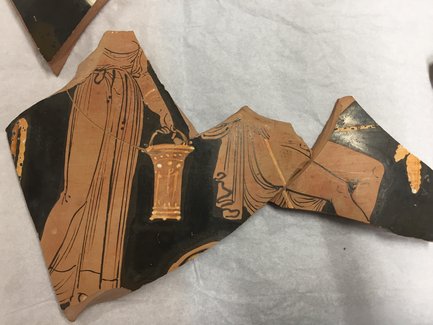The Museum of Ancient Art and Archaeology has begun a new research project into the international trade in antiquities based on a long term deposit of c. 1,500 fragments of pottery that derives from the ware house of the antiquities dealer Robin Symes in Geneva. They were ransacked by the Swiss police in 2014 together with a large number of other antiquities. All the objects were handed over to the Italian carabinieri in January 2016. The boxes with Apulian pottery arrived at the Museum of Ancient Art in January 2018 on loan through the Italian carabinieri and the Italian Ministry of Culture.
The fragments from the ware house are from painted vases that presumably have been illegally excavated in Apulia in Southern Italy and illegally exported out of Italy. Apulia has been a victim of large scale illegal excavations during the second part of the twentieth century.
 |  |
|---|---|
Since the 1970s the concept illicit antiquities has been applied to objects that have been plundered and illegal exported out of the country of origin and sold on the international art market. In the mid 1990s the Italian police has uncovered a large network of dealers involved in illegal trade in antiquities. Trade documents, photographs and other documents prove the illegal activities. Since then a large number of objects in museums and private collections have been returned to Italy and has been defined as ‘illegal antiquities’.
But what are we going to do with these illegal or illicit antiquities, or orphans as they are sometimes also called? In archaeological research it is argued that objects without an archaeological provenance should not be published in scholarly journals or books. This is partly because their lack the archaeological information that would qualify them as empirical material in much archaeological research where context and not the object in it self is essential. During the last century a gap has evolved between traditional art historical research that studies the objects themselves and archaeological research that focus on the contextual evidence. But is is also because a publication is a means to legitimizing the objects. When scholars publish objects they are provided with a history, a provenance, and this increases their value on the art market.
The fragments from the dealer’s warehouse is no longer on the market and this gives us the unique possibility to research and publish the material with legitimising them and contribute to the sanctioning of the illegal trade in antiquities.
Thanks to support from Aarhus University Research Foundation, we have employed the internationally recognised scholar in illegal trade in antiquities, Christos Tsirogiannis, as guest professor in autumn 2018. Tsirogiannis has focused on identifying objects in the art market that can be found in the many archives from dealers confiscated during the last 20 years. He has written his phd-thesis on the dealer Robin Symes and this is due to be published soon.
The project has two goals. One is to uncover the routes of the objects to the international antiquities market, the other to investigate which localities the objects might have come from and what their meaning was in Antiquity. Research in Apulian pottery has been very much directed through the fact that a very large part of the known objects surfaced on the antiquities market from the 1980s. There was a close cooperation between antiquity dealers and scholars, who classified the vases according to workshops and vase painters. The vases are decorated with rich illustrations of myths and daily life. Most of them were presumably used as grave goods as large monumental painted vases were part of the tomb equipment in South Italian cities in the fourth and third centuries BC. The vases and their decoration thus provides us with a rich visual source to the ideas of life and death in the region in that period.
The aim of the project is to develop a digital platform to publish the material and make it available to scholars globally facilitating a transparent and dynamic research environment. We will be testing the use of 3D scanning of fragments to make it possible to test if fragments in other collections might be joining.
To read more on Robin Symes:
Christos Tsirogiannis 2016:Attitudes in Transit: Symes Material from Market to Source, Journal of Art Crime Spring, 79–86.
David Gill 2016: Robin Symes, returns from Geneva and the Medici Dossier, on Looting Matters: http://lootingmatters.blogspot.dk/2016/02/robin-symes-returns-from-geneva-and.html
Peter Watson 2004: The Fall of Robin Symes, Culture without Context 15, 20-22
https://traffickingculture.org/publications/culture-without-context-2004-issue-15-cambridge-mcdonald-institute-for-archaeological-research/
Andrew Slayman 2006: The Trial in Rome, Archaeology Online Feature: http://archive.archaeology.org/online/features/italytrial/
Documents from Robin Symes Limited:
https://beta.companieshouse.gov.uk/company/01315755/filing-history?page=6